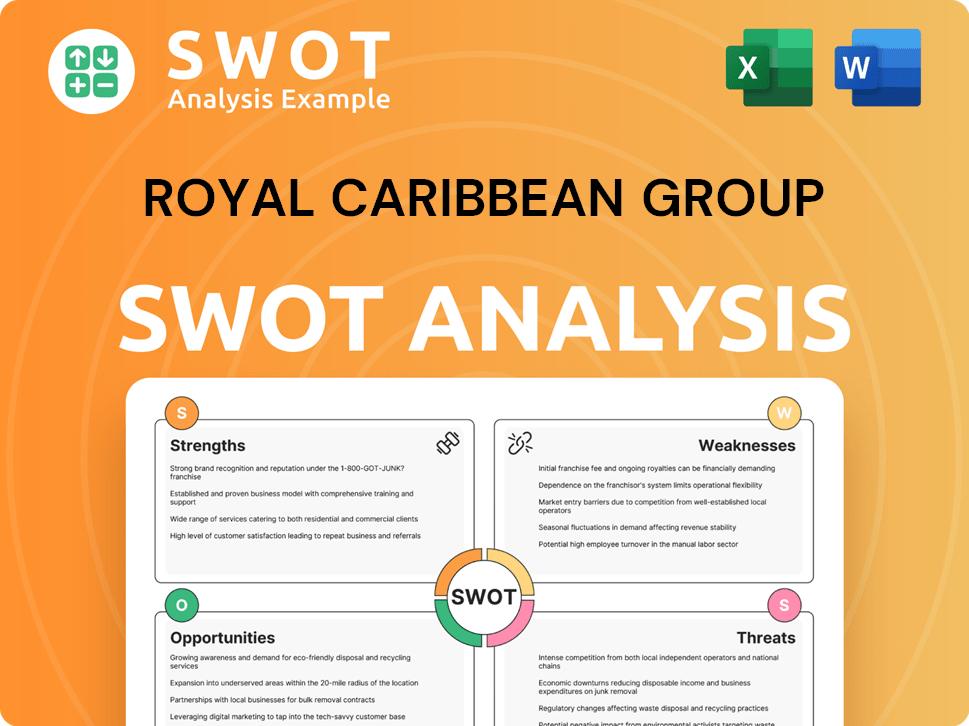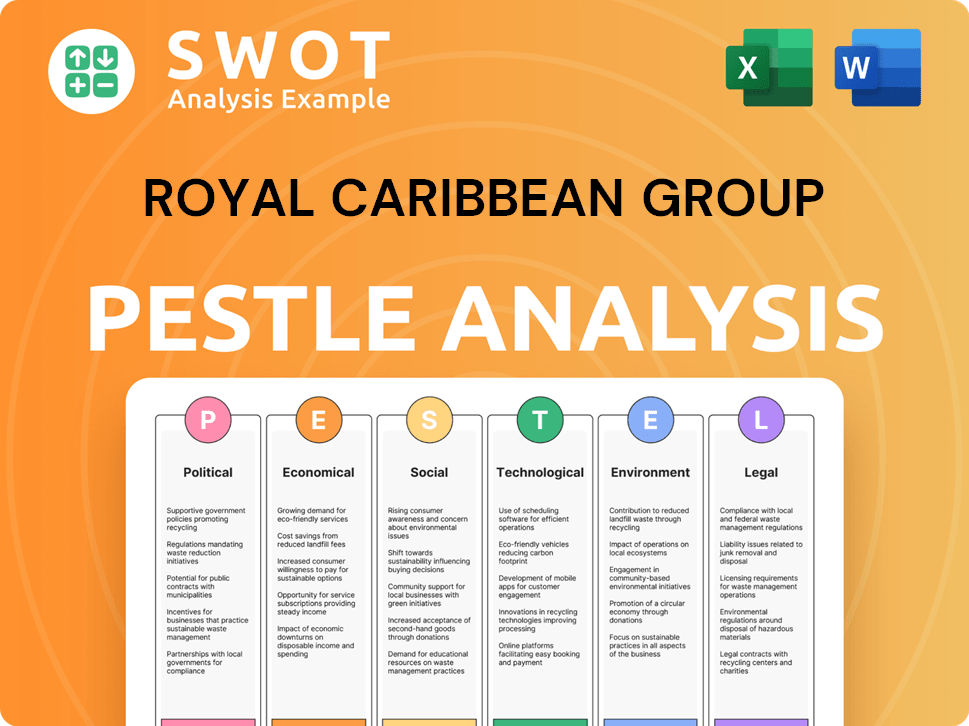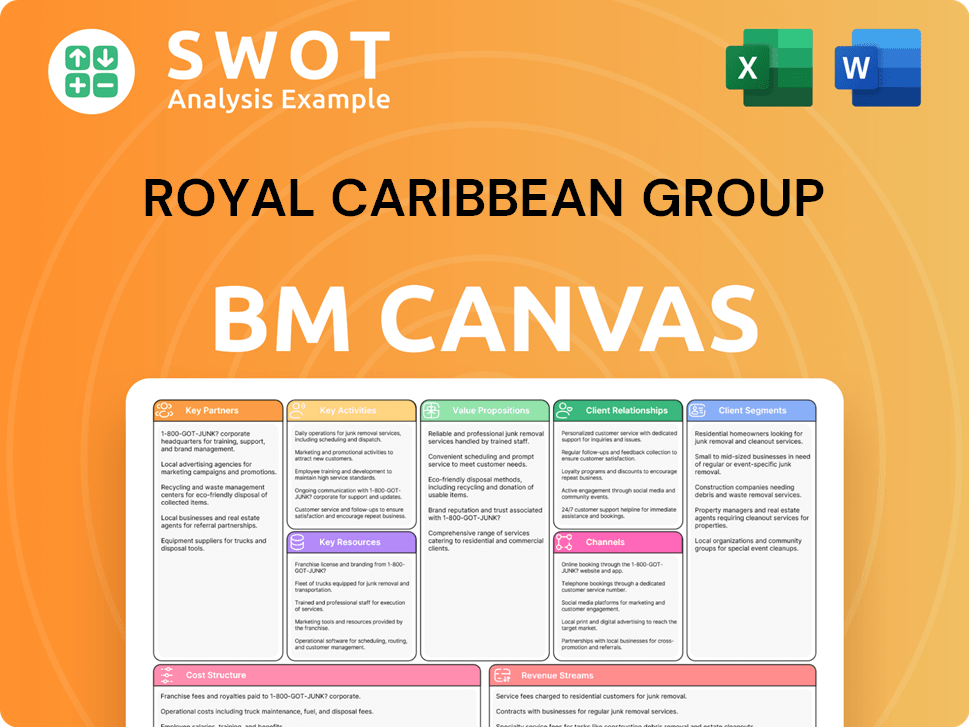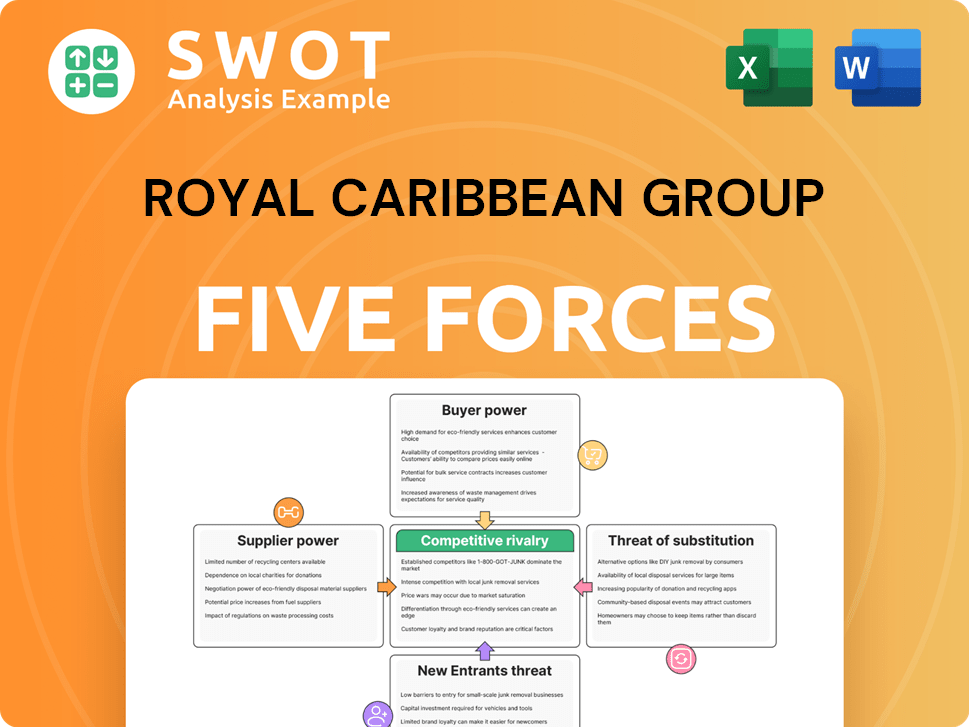Royal Caribbean Group Bundle
Who Sails with Royal Caribbean Group?
The cruise industry is constantly changing, and Royal Caribbean Group (RCL) must stay ahead of the curve. Understanding customer demographics and the Royal Caribbean target market is crucial for success in this dynamic sector. This knowledge allows the company to tailor its offerings and marketing to attract and retain cruise passengers.

Royal Caribbean Group's ability to adapt has been tested, especially after the pandemic, highlighting the need for a deep dive into its customer base. This analysis explores who Royal Caribbean's ideal customers are, examining their age demographics, income levels, and interests to better understand their travel preferences. A thorough Royal Caribbean Group SWOT Analysis can further illuminate the company's position within the travel industry, providing valuable insights into its market segmentation and customer acquisition strategy.
Who Are Royal Caribbean Group’s Main Customers?
Understanding the customer demographics and target market is crucial for the success of the Royal Caribbean Group. The company employs a multi-brand strategy, primarily operating within the Business-to-Consumer (B2C) model. This approach allows it to cater to diverse segments within the travel industry analysis, optimizing its offerings to meet various customer needs and preferences.
The Royal Caribbean target market is segmented across its various brands, each designed to appeal to a specific customer profile. This strategic segmentation enables the company to maximize its market reach and profitability by offering tailored experiences. The group's ability to adapt to changing consumer preferences and market trends is a key factor in its sustained success.
The company's success is also reflected in its financial performance. For instance, in 2024, Royal Caribbean Group reported a significant increase in revenue, demonstrating the effectiveness of its customer segmentation and market strategies. This growth is a testament to the company's ability to attract and retain customers across its diverse brand portfolio.
Royal Caribbean International primarily targets families, couples, and multi-generational groups. This brand focuses on providing active and amenity-rich vacations. The appeal lies in its diverse onboard activities, entertainment options, and accessible price points, making it a popular choice for a wide range of cruise passengers.
Celebrity Cruises caters to a more upscale demographic, focusing on adults and couples. This segment typically has higher income levels and seeks sophisticated dining, wellness, and enrichment programs. This brand is designed for those seeking a more luxurious and refined cruise experience.
Silversea Cruises targets the ultra-luxury market, attracting affluent travelers. This segment seeks exclusive, all-inclusive, and expedition-style voyages. This brand is characterized by very high income levels and a preference for personalized service and unique destinations.
Royal Caribbean Group strategically diversifies its offerings based on market research. This includes investing in new ships and itineraries tailored to specific customer profiles. The introduction of new vessels, like the Icon of the Seas in early 2024, exemplifies this strategy, designed to appeal to families with a wide array of entertainment and activity options.
The Royal Caribbean age demographics vary across brands, with Royal Caribbean International attracting a wide age range, from young children to seniors. Celebrity Cruises and Silversea Cruises target older adults and affluent travelers. Royal Caribbean income levels differ, with Royal Caribbean International catering to middle to upper-middle income levels, while Celebrity Cruises and Silversea Cruises target higher-income segments.
- Royal Caribbean customer interests include onboard activities, entertainment, and family-friendly vacations.
- Royal Caribbean family travel demographics are a significant focus for Royal Caribbean International, with tailored activities and amenities.
- Royal Caribbean destination preferences vary, with itineraries designed to appeal to diverse interests, from Caribbean cruises to global expeditions.
- Royal Caribbean customer behavior is influenced by factors like price, onboard experiences, and destination appeal.
For more insights into the competitive landscape, consider exploring the Competitors Landscape of Royal Caribbean Group. This analysis provides a broader understanding of the market dynamics and the strategies employed by Royal Caribbean Group to maintain its competitive edge.
Royal Caribbean Group SWOT Analysis
- Complete SWOT Breakdown
- Fully Customizable
- Editable in Excel & Word
- Professional Formatting
- Investor-Ready Format

What Do Royal Caribbean Group’s Customers Want?
Understanding the customer needs and preferences is crucial for the success of the Royal Caribbean Group. The company's approach to customer satisfaction is multifaceted, recognizing the diverse needs of cruise passengers across its various brands. This involves tailoring experiences to meet specific demographic profiles and lifestyle preferences, ensuring customer loyalty and driving repeat bookings.
The Royal Caribbean target market is broad, encompassing families, couples, and solo travelers, each with distinct expectations. Market segmentation allows the group to offer a range of cruise experiences, from family-friendly adventures to luxury getaways. This strategy is essential in the competitive travel industry analysis, ensuring that each brand caters to its intended audience.
The group's customer acquisition strategy focuses on understanding the motivations and desires of potential cruise passengers. By analyzing customer behavior and booking trends, the group refines its offerings to meet evolving demands. This includes adapting to changes in destination preferences and ensuring high levels of customer satisfaction.
Royal Caribbean International caters to families seeking value and entertainment. Key drivers include family-friendly activities, diverse dining, and popular destinations. The brand emphasizes group bookings and children's programs.
Celebrity Cruises targets customers seeking sophistication and enriching experiences. This includes culinary excellence, wellness options, and cultural programs. Purchasing involves detailed research into itineraries and shore excursions.
Silversea Cruises appeals to those seeking unparalleled luxury and personalized service. The focus is on bespoke itineraries, all-inclusive amenities, and intimate settings. Loyalty is built on highly personalized attention.
Common pain points addressed include hassle-free travel, diverse entertainment, and opportunities for relaxation. Feedback and market trends consistently influence product development. Sustainability and unique experiences are increasingly important.
Royal Caribbean International uses vibrant visuals and family testimonials. Celebrity Cruises highlights culinary artistry and serene escapes. Silversea Cruises emphasizes exclusivity and unique destinations. These approaches are detailed in the Marketing Strategy of Royal Caribbean Group.
In 2024, the cruise industry saw a significant increase in demand, with many lines reporting record bookings. The trend towards sustainable travel and unique experiences continues to grow. The group is adapting to these trends by developing more environmentally friendly ships and offering immersive shore excursions.
Customer demographics and interests vary significantly across the group's brands. Understanding these differences is crucial for tailoring offerings and marketing efforts effectively. The group uses market research analysis to stay informed about passenger profiles and cruise booking trends.
- Royal Caribbean International: Focus on family travel, with a high demand for onboard activities and value-driven itineraries.
- Celebrity Cruises: Appeals to a more affluent demographic seeking sophisticated experiences, with a preference for gourmet dining and cultural excursions.
- Silversea Cruises: Targets high-net-worth individuals looking for luxury, personalized service, and exclusive destinations.
- Geographic Demographics: The group's customer base is diverse, with significant representation from North America, Europe, and increasingly, Asia.
- Customer Lifestyle: The group caters to various lifestyles, from active families to couples seeking relaxation and adventure.
Royal Caribbean Group PESTLE Analysis
- Covers All 6 PESTLE Categories
- No Research Needed – Save Hours of Work
- Built by Experts, Trusted by Consultants
- Instant Download, Ready to Use
- 100% Editable, Fully Customizable

Where does Royal Caribbean Group operate?
The geographical market presence of Royal Caribbean Group (RCG) is extensive, focusing on major cruise markets globally. The company strategically targets regions including North America, Europe, Asia, and Australia, adjusting its offerings to suit the diverse preferences of its cruise passengers. This global approach allows RCG to tap into varied customer demographics and booking trends, optimizing its market segmentation strategies for sustained growth.
North America, especially the United States, represents RCG's largest market, characterized by high brand recognition and a substantial customer base. Key embarkation ports such as Miami, Fort Lauderdale, and Port Canaveral facilitate access for a wide range of customers. In Europe, the company tailors its services to meet regional tastes, offering multilingual support and culturally relevant entertainment to cater to diverse customer demographics.
Asia, particularly China, has been a significant growth market, although recent factors have influenced its trajectory. RCG has invested in ships designed specifically for the Chinese market, reflecting its commitment to adapting to local preferences. Australia and New Zealand are also important markets, especially for cruises to the South Pacific and within the region. This strategic deployment of resources demonstrates RCG's adaptability and commitment to meeting the evolving demands of the travel industry analysis.
The United States remains the primary market for RCG, with significant market share and brand recognition. Major ports like Miami and Fort Lauderdale serve a vast domestic customer base. RCG continues to innovate its offerings to maintain its strong position in this key geographical segment, focusing on Royal Caribbean target market preferences.
In Europe, RCG targets key markets such as the United Kingdom, Germany, and Italy, tailoring its offerings to regional tastes. This includes multilingual services and culturally relevant entertainment to cater to diverse Royal Caribbean age demographics. Itineraries are often customized, with a greater emphasis on historical and cultural excursions to attract various customer interests.
Asia, especially China, is a significant growth market, with RCG investing in ships designed for local preferences. These vessels feature amenities and services tailored to local tastes, reflecting RCG's strategy to expand its global footprint. However, geopolitical and pandemic-related factors have influenced its trajectory, requiring strategic adjustments in Royal Caribbean group operations.
Australia and New Zealand are important markets, particularly for cruises to the South Pacific. RCG offers itineraries that cater to the preferences of these regions, enhancing its appeal to Royal Caribbean family travel demographics. This focus supports RCG's commitment to providing diverse experiences and expanding its reach in the South Pacific.
RCG continually analyzes the geographic distribution of sales and growth to inform strategic decisions, including homeport selection and itinerary development. Recent expansions have focused on new homeports and itineraries in emerging markets. Strategic withdrawals or reallocations of ships may occur based on demand and operational efficiencies. For example, Growth Strategy of Royal Caribbean Group highlights the company's commitment to expanding its reach, deploying ships to new homeports, and offering a wider array of itineraries globally in 2024 and 2025.
Royal Caribbean Group Business Model Canvas
- Complete 9-Block Business Model Canvas
- Effortlessly Communicate Your Business Strategy
- Investor-Ready BMC Format
- 100% Editable and Customizable
- Clear and Structured Layout

How Does Royal Caribbean Group Win & Keep Customers?
The customer acquisition and retention strategies of focus on a blend of digital and traditional marketing, robust sales tactics, and loyalty programs. These strategies are designed to attract new customers while cultivating long-term relationships with existing ones. Through data-driven personalization and a focus on customer experience, the company aims to maximize customer lifetime value and maintain a competitive edge in the travel industry.
Digital marketing, including SEO, PPC, and social media, is a cornerstone of their approach, alongside traditional advertising and partnerships with travel agencies. Loyalty programs and personalized experiences, supported by CRM systems, are central to retaining customers. After-sales service and successful acquisition campaigns, often highlighting new features and itineraries, are also crucial.
The company's customer acquisition strategy involves a multi-channel approach, leveraging both online and offline channels to reach potential cruise passengers. Key components include digital marketing, traditional advertising, and partnerships with travel advisors. The goal is to attract a diverse range of travelers and drive bookings across its various cruise lines.
Digital marketing is a core element, using SEO, PPC, and social media (Facebook, Instagram, TikTok). Email marketing campaigns and influencer collaborations are also utilized to reach target audiences. These efforts aim to enhance online visibility and drive direct bookings.
Traditional channels like TV commercials and print media still play a role. Partnerships with travel agencies are critical for sales, providing a significant booking channel. These strategies ensure a broad reach across various customer segments.
Direct booking options via websites and call centers are emphasized. A strong network of travel advisors supports sales efforts. These tactics provide customers with multiple convenient booking pathways.
Loyalty programs like Crown & Anchor Society offer tiered benefits to encourage repeat bookings. These programs include discounts, exclusive access, and onboard credits. These programs foster customer loyalty and repeat business.
Retention strategies focus on building customer loyalty and enhancing the overall cruise experience. This includes personalized experiences, after-sales service, and continuous improvements to onboard offerings. The goal is to foster strong customer relationships and increase customer lifetime value, reducing churn rates.
Loyalty programs like the Crown & Anchor Society offer tiered benefits. These benefits include discounts, exclusive access, and onboard credits. These incentives encourage repeat bookings and build customer loyalty.
Customer Relationship Management (CRM) systems are used to personalize marketing and onboard offerings. Data analysis helps tailor promotions and services to individual preferences. This personalization enhances customer satisfaction and loyalty.
After-sales service is crucial for a positive customer journey. This includes pre-cruise information, onboard assistance, and post-cruise follow-up. Excellent service encourages repeat business and positive word-of-mouth.
Successful acquisition campaigns often highlight new ship features and unique itineraries. The launch of Icon of the Seas, for example, generated significant booking interest. Strategic promotions drive customer engagement.
The company has increased its focus on digital engagement and direct-to-consumer marketing. Enhancements to mobile apps improve the pre-cruise and onboard experience. These efforts streamline processes and provide personalized information.
Continued support for travel advisors remains a key part of the strategy. Travel advisors are a significant channel for bookings. This support ensures a strong distribution network.
The company monitors several KPIs to measure the effectiveness of its acquisition and retention strategies. These include customer acquisition cost, customer lifetime value, and churn rate. The focus is on maximizing customer lifetime value and fostering strong customer relationships.
- Customer Acquisition Cost (CAC): Measures the cost of acquiring a new customer.
- Customer Lifetime Value (CLTV): Predicts the net profit attributed to the entire future relationship with a customer.
- Churn Rate: Indicates the percentage of customers who stop using a company's product or service during a specific period.
- Repeat Booking Rate: Measures the percentage of customers who book another cruise.
In 2024, the cruise industry saw strong demand, with many companies reporting record bookings. The company's investments in digital marketing and personalized experiences are designed to capitalize on this trend and maintain its competitive position. By focusing on customer satisfaction and loyalty, the company aims to sustain long-term growth and profitability. For more details, you can explore the [Royal Caribbean Group's customer acquisition strategy](0).
Royal Caribbean Group Porter's Five Forces Analysis
- Covers All 5 Competitive Forces in Detail
- Structured for Consultants, Students, and Founders
- 100% Editable in Microsoft Word & Excel
- Instant Digital Download – Use Immediately
- Compatible with Mac & PC – Fully Unlocked

Related Blogs
- What are Mission Vision & Core Values of Royal Caribbean Group Company?
- What is Competitive Landscape of Royal Caribbean Group Company?
- What is Growth Strategy and Future Prospects of Royal Caribbean Group Company?
- How Does Royal Caribbean Group Company Work?
- What is Sales and Marketing Strategy of Royal Caribbean Group Company?
- What is Brief History of Royal Caribbean Group Company?
- Who Owns Royal Caribbean Group Company?
Disclaimer
All information, articles, and product details provided on this website are for general informational and educational purposes only. We do not claim any ownership over, nor do we intend to infringe upon, any trademarks, copyrights, logos, brand names, or other intellectual property mentioned or depicted on this site. Such intellectual property remains the property of its respective owners, and any references here are made solely for identification or informational purposes, without implying any affiliation, endorsement, or partnership.
We make no representations or warranties, express or implied, regarding the accuracy, completeness, or suitability of any content or products presented. Nothing on this website should be construed as legal, tax, investment, financial, medical, or other professional advice. In addition, no part of this site—including articles or product references—constitutes a solicitation, recommendation, endorsement, advertisement, or offer to buy or sell any securities, franchises, or other financial instruments, particularly in jurisdictions where such activity would be unlawful.
All content is of a general nature and may not address the specific circumstances of any individual or entity. It is not a substitute for professional advice or services. Any actions you take based on the information provided here are strictly at your own risk. You accept full responsibility for any decisions or outcomes arising from your use of this website and agree to release us from any liability in connection with your use of, or reliance upon, the content or products found herein.